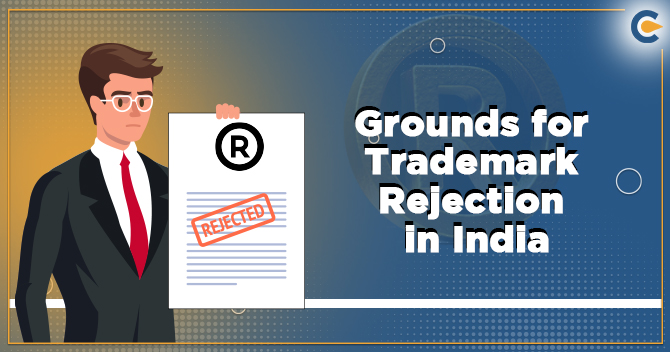A registered trademark can help the owner of the trademark prevent any unauthorized use of the mark and create an important intangible asset for your company. The trademark registration process is long normally taking anywhere between 12-18 months time to know the final status of any filed trademark application. The application process for trademark takes a long time, many industry begin creating a brand around a trademark while the trademark application is still pending. Consequently, we look at some of the top grounds for Trademark Rejection in India.
What are the Grounds for Trademark Rejection?
A trademark application is inspected comprehensively by the officials of the Trademark Registry. If they find any kind of infringement of the law or violation of any other registered trademark then they can reject the application for registration of the trademark. The status of the application will show as “Marker for Exam”.
The Grounds for Trademark rejection are as follows-


Correct Application Procedure
The first thing the inspector will look for is whether the application filed is as per to the process and all the information has been provided is according to the Trademark Act. If the inspector finds anything incorrect with the process or the documents required for the application then they will reject the application for Trademark.
If Similar to any Registered Trademark
When applying for trademark one has to make sure that the mark selected for registration is not similar to an already existing trademark. This can be done by doing a public search on the official website of Intellectual Property India that is the Controller General of Patents, Designs and Trademarks. If it is found by the inspector that the trademark that is being applied for is similar to an already registered trademark then the application for Trademark is rejected.
Descriptive Words or Design
If the mark consists of any descriptive words or terms that are commonly used to identify any product then the application for trademark will be rejected. For example, if anyone tries to trademark the word ‘SWEET’ for products like chocolate then the application will be rejected as it will be not fair for other similar products.
General Words or Design
General words like PENCILS cannot be trademarked for selling the same products as only one company cannot have the right to use these terms and use it uniquely. So such trademark can be rejected from registration by the examiner.
Offensive Terms or Design
A trademark cannot include any offensive term or design because such marks will be against the public morality as well as order of the public. Therefore, in terms of designs that are unpleasant will usually be rejected by the inspector.
Confusing Terms or Design
A confusing mark or a misleading mark can be any mark that leads the customers to believe incorrectly about the origin, quality, producer, material etc of any product. For example, if a mark is of n ORANGE but the product is red meat the mark can be rejected on the grounds that it is misleading in terms.
Official Designs or Words
If the mark consists of any official words, terms, designs or pictures then it will be rejected for registration by the inspector as it is against public welfare. It can fallaciously convince the consumer that it is excused by an official body.
Conditions and Restrictions
If the inspector feels the mark is valid but still needs some situation or changes to its use or appearance then the application for Trademark can be rejected.
Read our article:Grounds for the Refusal of the Trademark Registration
What sort of Objection in Case of Trademark Rejection can get Arise?
After the inspector has analyzed the Trademark for registration they have the right to object the registration. The status of the application will show “Objected”. At this point, the candidate has the chance to put forward his case to the inspector. Generally, the objection is raised under Section 9 or Section 11 of the Trademark Act.
Objection under Section 9 of Trademark Act
Section 9 of the Trademark Act gives absolute grounds for refusal of registration. Section 9 rejects any trademark that is:


How to counter the objection under Section 9?
To counter the objection under Section 9 the applicant is required to prove that the trademark of the candidate can be easily eminent by the customer pertaining to the goods & services provided.
Objection under section 11 of the Trademark Act
Section 11 of the Trademark Act provides for relative grounds for refusal of registration. If the inspector objects under this section it will because the mark has similarities with an already registered trademark.
In this case, the inspector has to attach the conflicting parts of the trademark as well as the trademark with which it is conflicting. The applicant has to conquer the objections sited by the inspector. It has to be done as per the section under which the objection is raised.
How to counter the objection under Section 11?
The applicant has two options-
- Test that the mark is different from the conflicting mark. The applicant is required to prove that his mark is distinctively different from the conflicting mark and can absolutely be distinguished as two separate marks.
- Get a No Objection Certificate (NOC) from the owner of the conflicting registered mark.
What is the scenario for Refusal of the Trademark Registration?
Once the inspector has taken into deliberation that the arguments of the applicants is against the objection of the Trademark registration they has the right to finally decide whether to allow the trademark to be registered.
The inspector will either push the status of the application to Exam Report Issued that states it has been approved and will be published in the official gazette that is Trademark Journal to open the chance for third parties to object. Or put the status to Refused that means the application for registration has been rejected.
How to file Appeal in case of Trademark Rejection?
If the registration of trademark is refused then the applicant has the final option to file for an appeal under the Intellectual Property Appellate Board (IPAB). An appeal to the IPAB should be filed electronically within 3 months of the date of issuance of the order of refusal by the registrar. The time limit can be extended if the appellant shows reasonable cause to why the appeal was filed in the Intellectual Property Appellate Board after the time limit.
Appeal to the Intellectual Property Appellate Board has two different type of process depending upon the type of registration that was required by the applicant or the appellant. The appeal has to be filed in the prescribed manner following the Trademarks Rules.
Conclusion
It is very important to understand the importance of protecting any trademark. The entire idea of publicity, advertising and sale are built around to maintain the brand image thus making it very significant to make sure trademarks are registered for the business.
Many owners file a trademark application without required knowledge of the Trademark, leading to Trademark rejection and loss of valuable time in protecting the trademark rights.
Read our article:A Deep Analysis on Benefits of Trademark Registration











